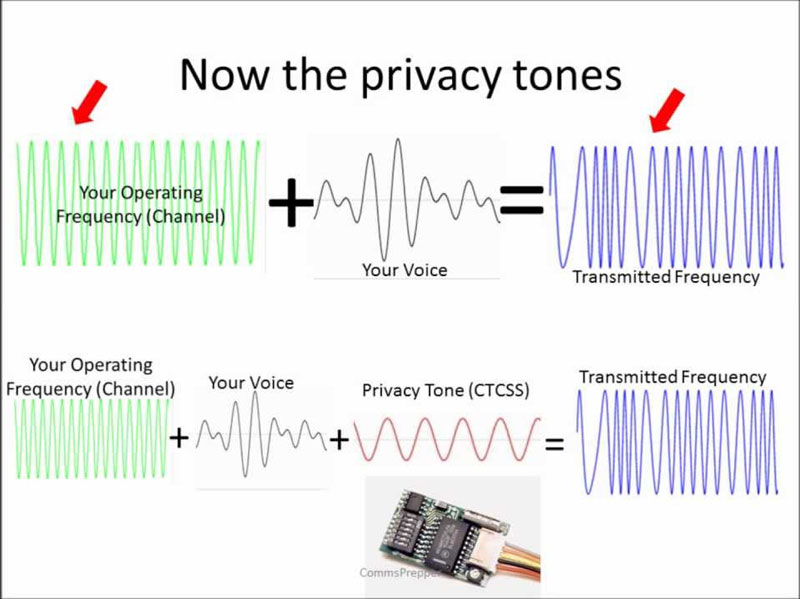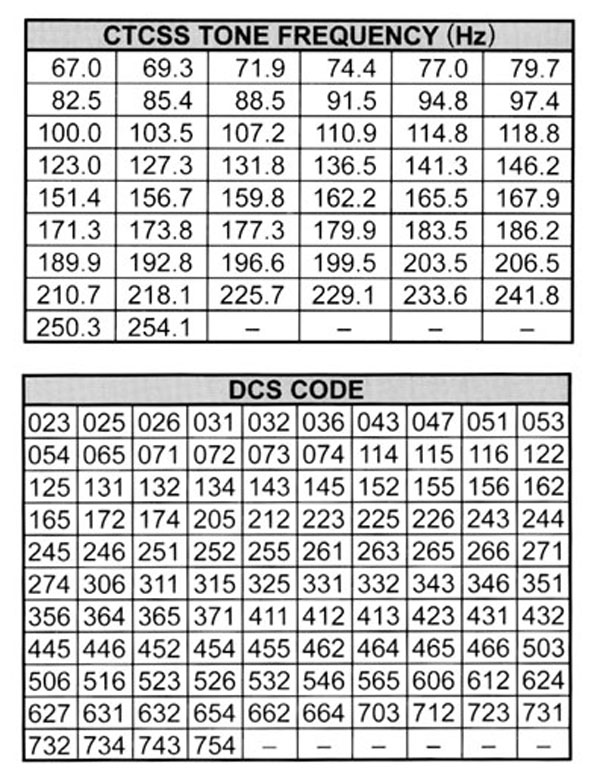Let’s talk about CTCSS and DCS today . Talk about What they are and what the difference of them?
CTCSS
CTCSS stands for Continuous Tone Coded Squelch System. Basically what it does is this: it adds a tone into your transmission at a certain frequency. Other radios must have the same CTCSS tone or code set to hear the transmission. It will also be heard if the radio has CTCSS and DCS off. Different CTCSS codes have different frequencies, and this is how it filters out other people – as long as they have a different CTCSS, or no CTCSS, then your radio will not pass any audio to the speaker.
When CTCSS is used, the audio is filtered out below about 300Hz, so that the only audio frequency energy that ends up being transmitted between 0 and 300Hz is the CTCSS tone itself (almost always any one tone between 67 and 254.1 Hz). The tone is then sometimes called ‘sub audible’ because it’s below the range of THEN audible voice frequencies – but it would be audible if played on full range speakers without the filtering that CTCSS radio receivers also use on receive (we can hear down to 20Hz or so).
DCS
DCS works the same, apart from it being digital instead. It stands for Digitally Coded Squelch. It sends a number repeatedly encoded in digital as you speak, in the low frequencies so you do not hear it. If someone else transmits on the channel with a different or no DCS, the radio will not unmute. If they transmit with the same DCS as you, then your radio will unmute. DCS is newer than CTCSS, and has more combinations.
The Difference
Unlike CTCSS (Continuous Tone Coded Squelch System) which uses continuous tones below 300 Hz., DCS uses digital data or code words. Each code word is unique and all code words may be used on the same channel without interference. At the end of the radio transmission and about 1/2 second before the transmitter un-keys, the radio will encode a 134 Hz tone that serves as a turn off code. The FM deviation level of DCS data should be in the range of 500 to 800 Hz.
Unlike CTCSS, DCS signal spectrum occupies considerable more bandwidth. A poor low frequency response in the transmitter or receiver may not seriously distort a single frequency tone signal but may seriously degrade a wide band signal containing multiple frequency components. The distortion risk is especially high if the frequency response delays the wide band frequency components.
You will find that it is extremely important for the receiver and transmitter to be on frequency to achieve maximum performance of the DCS function. Errors in the transmitter and receiver frequencies show up a the discriminator output as a step function. Because of the long time constant required for the low frequency response, a step function can block the decoder momentarily. With DCS, error correction is necessary. But if too many errors occur, you may experience some blocking out of the decoder. Errors can occur because of unwanted low frequency energy. The DCS decoders can be effected by voice energy that falls below 300 Hz. Some radios do not remove this energy before transmission and can cause voice blocking of the decoder. A sub audio filter that removes this low frequency energy before the audio is re-transmitted is necessary for reliable DCS operation.
Now there are a few systems that use both the DCS and CTCSS on one side or the other and even using both.
Please see the standard data of CTCSS and DCS.
Views: 471



I tried the instructions to make the rt-81 talk to the h777 it did not work, are there more detailed instructions for the rt-81 and the h777
what step you got trouble ?
How do I make your rt21 and rt22 models work together?
hi, first you need to get a cable, then download both softwares to program your radio.
Only all channels Tx and RX frequency same as the other one, and CTCSS/DCS same as the other one, they can talk with each other.
If question, please email us: partner@retevis.com
When is it better to use CTCSS, and when is it better to use DCS?
I am using RT24 radios.
If you have a check on software , you will find they are together in one line . Both OK .No difference when using .
How do I disable the beep after I press the ptt button
Hello, dear
Could you tell me your radio model? Thanks.
Best regards,
Retevis
3 new H777. cloned info from older h777. programming info reads identical new and old radios. new radios appear not to have ctcss or dcs encode or decode. the radios will not communicate unless monitor button, (the upper orange button) is depressed. the ctcss and dcs is identical on all radios.
Hi, dear, we have sent you a file, please pay attention to receive them, stay safe and have a nice day!
I bought my son a pair of RT30. I got myself a pair of RB615. How which parameters have to enter in my RB615 to transmit to RT30? I know RT30 transmit on channel 8 Subtone 99, but I do not know how to set up RB615. Thanks!!
are you able to tell me how to remove the CTCSS code on a Cobra walkie talkie?
It is better to contact your direct seller about your radio issues.
I have retevis rb27. Some on our community have other radios. I had to turn of the ct codes for the channel we use, but can’t find a way to turn off dcs codes. How do you do that?
you need to use the software to close
My work uses RT22 radios to communicate, I have an off brand FRS radio that is somewhat programmable.
When I transmit from my off brand radio, the RT22 lights up as though it is receiving signal, but no audio goes through.
However when I transmit from the RT22, I can hear the audio on my off brand radio.
I think the problem is with the CTCSS or DCS codes, but I cannot determine what codes the RT22 is using; I don’t have the ability to update the RT22 from a computer, as my work does not have the cables for it
How can I fix this problem, or find the codes the RT22 is using?